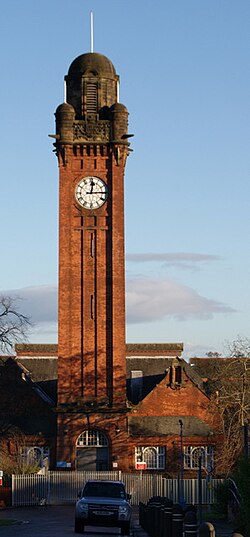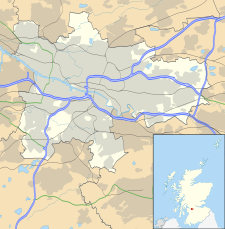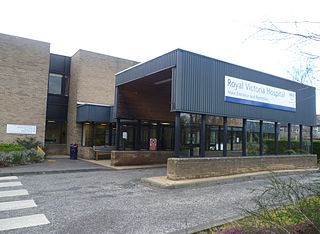
The Royal Victoria Hospital was a health facility at Craigleith Road in the north-west of Edinburgh, Scotland. It was formerly the main Medicine for the Older Adult assessment and rehabilitation hospital for the north of Edinburgh. It closed in 2012, then briefly reopened to ease pressure on acute beds in the region. The facility finally closed in early 2017 and was not in use when a fire caused damage to buildings in May 2017. It was managed by NHS Lothian.
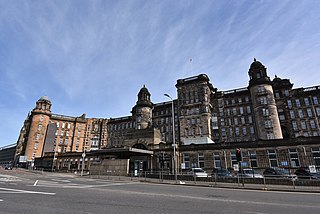
The Glasgow Royal Infirmary (GRI) is a large teaching hospital. With a capacity of around 1,000 beds, the hospital campus covers an area of around 8 hectares, and straddles the Townhead and Dennistoun districts on the north-eastern fringe of the city centre of Glasgow, Scotland. It is managed by NHS Greater Glasgow and Clyde. It was originally opened in 1794, with the present main building dating from 1914.
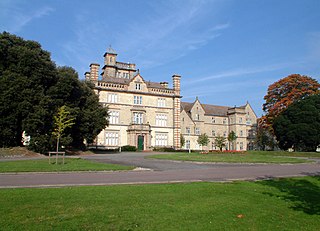
Fulbourn Hospital is a mental health facility located between the Cambridgeshire village of Fulbourn and the Cambridge city boundary at Cherry Hinton, about 5 miles (8 km) south-east of the city centre. It is managed by the Cambridgeshire and Peterborough NHS Foundation Trust. The Ida Darwin Hospital site is situated behind Fulbourn Hospital. It is run and managed by the same trust, with both hospitals sharing the same facilities and staff pool.
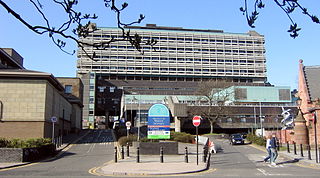
The Western Infirmary was a teaching hospital situated in Yorkhill in the West End of Glasgow, Scotland, that was managed by NHS Greater Glasgow and Clyde. It was opened in 1874 and closed in 2015.

The Royal South Hants Hospital, known locally as "The RSH", is a community hospital in Southampton. It is managed by NHS Property Services.
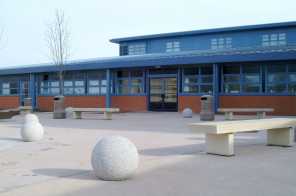
University Hospital Hairmyres is a district general hospital in the Hairmyres neighbourhood of East Kilbride, South Lanarkshire, Scotland. The hospital serves one of the largest elderly populations in Scotland. It is managed by NHS Lanarkshire.

NHS Greater Glasgow and Clyde is an NHS board in West Central Scotland, created from the amalgamation of NHS Greater Glasgow and part of NHS Argyll and Clyde on 1 April 2006.

Gartnavel Royal Hospital is a mental health facility based in the west end of Glasgow, Scotland. It provides inpatient psychiatric care for the population of the West of the City. It used to house the regional adolescent psychiatric unit but this has recently moved to a new psychiatric unit at Stobhill Hospital. The Hospital is a venue used by the Mental Health Tribunal for Scotland. Some parts of the hospital are classified as a category A building and are also deemed at risk.

NHS Borders is one of the fourteen health boards within NHS Scotland. It provides healthcare services for the Scottish Borders, the south east region of Scotland. NHS Borders is headquartered in Melrose.

The Royal Alexandra Hospital (RAH) is the main hospital in Paisley serving a large catchment area stretching all the way to Oban and Argyll. The hospital is managed by NHS Greater Glasgow and Clyde.

University Hospital Wishaw is a district general hospital in Wishaw, North Lanarkshire, situated between the areas of Craigneuk to the north and Netherton to the south. The hospital, managed by NHS Lanarkshire, is 11 miles southeast of Glasgow.

Lorn & Islands Hospital is a rural general hospital on the southern outskirts of Oban in Argyll, Scotland. It is managed by NHS Highland.

Midpark Hospital is a modern acute mental health unit located in Dumfries. The hospital is managed by NHS Dumfries and Galloway.
Callington Road Hospital is a psychiatric hospital in Bristol, England. Opened in 2006, it primarily replaced Barrow Hospital, providing psychiatric inpatient and community services for Bristol and the surrounding region. It is run by the Avon and Wiltshire Mental Health Partnership NHS Trust.

The Queen Elizabeth University Hospital (QEUH) is a 1,677-bed acute hospital located in Govan, in the south-west of Glasgow, Scotland. The hospital is built on the site of the former Southern General Hospital and opened at the end of April 2015. The hospital comprises a 1,109-bed adult hospital, a 256-bed children's hospital and two major Emergency Departments; one for adults and one for children. There is also an Immediate Assessment Unit for local GPs and out-of-hours services, to send patients directly, without having to be processed through the Emergency Department. The retained buildings from the former Southern General Hospital include the Maternity Unit, the Institute of Neurological Sciences, the Langlands Unit for medicine of the elderly and the laboratory. The whole facility is operated by NHS Greater Glasgow and Clyde, and is one of the largest acute hospital campuses in Europe.

Andover War Memorial Hospital is a community hospital in Andover, Hampshire. The hospital provides inpatient rehabilitation, day hospital services, a minor injury unit and an outpatient unit. It is operated by Hampshire Hospitals NHS Foundation Trust, but some services are provided by Southern Health NHS Foundation Trust. The Countess of Brecknock Hospice is located on the same site as the hospital. The independent regulator of health and social care in England, the Care Quality Commission, rated Andover as "requires improvement" overall in 2018.

Ailsa Hospital is a mental health facility located in the southeastern outskirts of Ayr, South Ayrshire, Scotland. It is managed by NHS Ayrshire and Arran.

The Gordon Hospital is a 55-bed acute adult mental health hospital located in Westminster, London. It is managed by the Central and North West London NHS Foundation Trust.

Woodland View is an acute mental health hospital, acute adult services and elderly and community rehabilitation facility located within the grounds of Ayrshire Central Hospital, Irvine, North Ayrshire, Scotland. The hospital was constructed by Balfour Beattie Construction, and opened in 2016.
Atherleigh Park Hospital is a mental health facility at the former Leigh East rugby league ground on Atherleigh Way in Leigh, Manchester, England. It is managed by Greater Manchester Mental Health NHS Foundation Trust.
